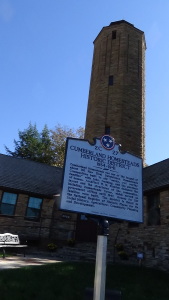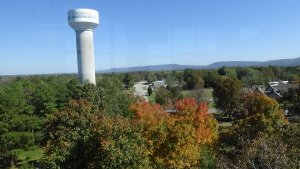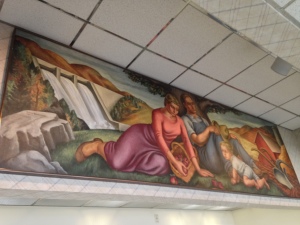As President Franklin D. Roosevelt took office in 1932 during the Great Depression, he swiftly initiated the New Deal to provide jobs and relief to the unemployed in Tennessee and throughout the U.S.
The people of Tennessee benefited from New Deal programs such as the Civilian Conservation Corps (CCC), Civil Works Administration (CWA) and the Works Projects Administration (WPA), which created jobs for laborers and artists in several genres. The results of their projects are still visible throughout the state.
The WPA appropriated 60 percent of its funds for roads, but workers “also built sewer systems, bridges, waterways, dams, viaducts, and overpasses.”

John McPeters, a faculty member of Clarkrange (Tennessee) High School and graduate of Carson-Newman University (Jefferson City, Tenn.), has been teaching history for 18 years. He said that he admires Roosevelt’s “will, his resolve, his personal triumphs, … and just his fix-it spirit.
“[Roosevelt] told everyone to take a deep breath,” said McPeters, “and said, ‘Here’s what we’re going to do.’ I really like the approach he took when he came into office in ‘32, and he really, really thought things out.”
In Tennessee, the WPA was headquartered in Nashville and employed more than 30,000 people per year for eight years. One of the biggest contributions to the country—through the Federal Writers’ Project—was the state guidebook series, including ‘The WPA Guide to Tennessee.’
McPeters said, “We kind of stimulated the economy ourselves. This country wasn’t without money. It had just been really, really mismanaged—especially after the stock market crash. As a matter of fact, when FDR closed the banks, they weren’t closed all that long. He kind of fixed them. … It wasn’t only the FDIC. It was some other programs, as well, but once he got the banks back on their feet, we had money to stimulate the economy. … We would have to dig down deep and get our own money to start these programs.”

In Crossville, the New Deal manifested itself in the Cumberland Homesteads society. Emma Vaden, the daughter of one of the first couples to be approved for the Homesteads project, said, “We must preserve our history. She and her husband started the Cumberland Homesteads Tower Association and the museums in 1984.
Architect William Macy Stanton envisioned this resettlement community “as a model of cooperative living for the region’s distressed farmers, coal miners, and factory workers.”
Vaden also said, “Education was a good thing that … the government planned [for the Homesteads]. They wanted people to go to high school and … there was a stone house up there—a pretty nice house. Instead of tearing it down because that’s where the [water] tower was going to be, they moved it with horses. They put it on skids and moved it. … and they made that a home economics cottage. And they outfitted it to teach kids in the ‘40s exactly how to run a household. … Behind that—down in the back—they had a shop. … Over on the end, they had a greenhouse, so they taught them agriculture. They were preparing them for their futures.”

The CCC and the National Park Service (NPS) built Cumberland Mountain State Park, which was designed as a recreational area for Homesteads residents. The CCC also built the dam and bridge for man-made Byrd Lake, as well as trails, cabins and other facilities. TheLivingtheNewDeal.com identifies Byrd Creek dam as the “largest masonry project every completed by the CCC.”

The archives of the Franklin D. Roosevelt Presidential Library and Museum list several murals commissioned in the Upper Cumberland. Just inside the Crossville post office on Old Jamestown Highway, visitors can see “The Partnership of Man and Nature” mural painted by Marion Greenwood. The artist worked with another New Deal program called the Tennessee Valley Authority. According to a statement posted near the mural, Greenwood incorporated an image of a dam to “show how harnessed water power could benefit the people.”
WPA laborers left other remnants of their progress. They built a Colonial-Revival style post office on the town square in Livingston in 1936, and Margaret Covey Chisholm completed “The Newcomers” mural in 1940 to decorate its lobby. They also also completed the Mt. Pleasant post office in 1940, and WPA commissioned the mural “Early Settlers Entering Mt. Pleasant” by Eugene Higgins to be painted in its lobby.
The WPA financed the building of the Alvin C. York Agricultural Institute in Jamestown in 1935. While the original building is not currently in use by students, the Sergeant York Patriotic Foundation is trying to preserve the legacy of WWI hero Sergeant York.
Shiloh National Military Park stands as an interpretive site for its famous Civil War battle of 1862; however, in 1934, WPA workers discovered a pre-Columbian village on the eastern side of Shiloh Hill. Excavators found 12 houses with adobe fireplaces. In addition sharing Civil War history, interpreters give details of how the Native Americans lived in that area.
McPeters said, “When I worked over at the [Frozen Head] state park in Morgan County when I was a teenager—there are some things built by the CCC. … and they pointed some of the things out that were built by the CCC.”
Calvin Dickinson, a professor emeritus of history at Tennessee Tech University, wrote about other New Deal projects that benefited the Upper Cumberland: Pickett State Park (Pickett County), Standing Stone Park (Overton County), Fall Creek Falls State Park (Van Buren County), the football field at Tennessee Polytechnic University (Putnam County).